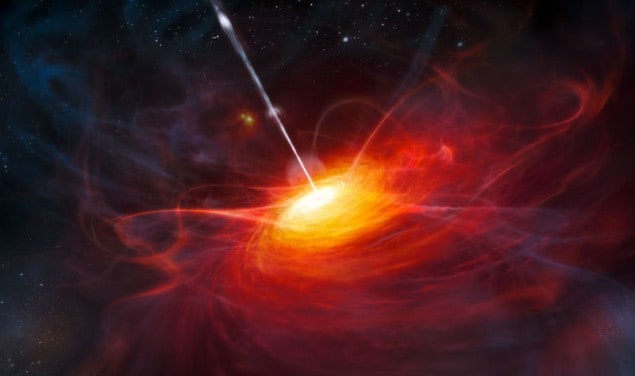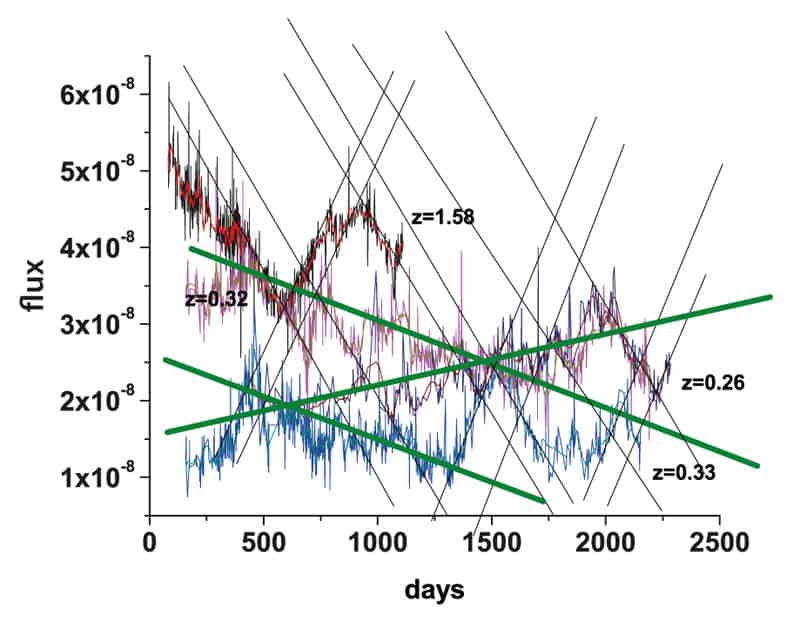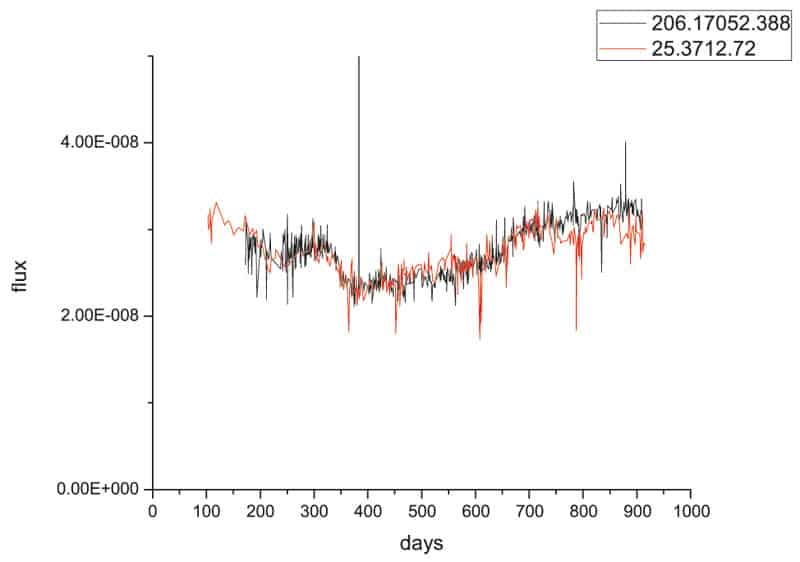
An international team of scientists has developed a method to determine the distances to quasars throughout the universe. This could allow quasars to be used as standard candles. The researchers found characteristic patterns in the light given off by a group of quasars and say that these regularities are directly related to the redshift of the quasar. This allows them to reliably derive the unknown redshift – how fast objects are moving away from one another in the expanding universe – of one quasar from the known redshift of another.
Astronomers are always keen to find new and accurate methods to measure cosmic distances and the expansion of the universe. “Standard candles” such as Cephids and supernovae have played important roles in astronomy. Indeed, the discovery of the accelerating expansion of the universe through observations of distant supernovae won Saul Perlmutter, Adam Riess and Brian Schmidt the 2011 Nobel Prize for Physics. But using supernovae to gauge the extreme distances of the universe has its problems – the furthest known supernova is at a redshift of about 1.7 and so reliable measurements of distances greater than that are not possible using supernovae. Also, astronomers have to wait for stars to “go supernova” and then have a short window of time to make their observations.
Contrary to that, the furthest quasar has been found at a redshift of about 7.1, and so looks much further back to the beginnings of the universe. Also, quasars are some of the brightest objects in the universe, and unlike supernovae can be studied for much longer time scales. Unfortunately, quasars emit different amounts of light in all wavelengths, and this makes it very difficult to use them to measure cosmological distances using their luminosity–distance relation. It was only last year that another team of researchers showed that it was possible to use the luminosity–radius relation of active galactic nuclei – a type of quasar – to determine their distance; using them as standard candles.
Quasar light patterns
But as it happens, quasars also have regularities in their light curves – how they brighten and dim over time – that could easily be used to determine their redshifts. Dejan Stojkovic from the State University of New York (SUNY) at Buffalo, US, and colleagues found that using the light curves to calculate the redshift of a quasar, independent from its luminosity–distance relation, would then allow quasars to be used as standard candles. They studied the publicly available light curve data from the Massive Compact Halo Objects (MACHO) project, which looked at quasars behind Magellanic Clouds.
“Potentially, quasars are much better [standard candles], but we still do not know them well enough,” says Stojkovic. “Until we noticed that the light curves of quasars follow certain patterns, no known regularities had been studied. And that was because they do look completely different at first glance,” he explains.
The team plotted a graph of the flux of a quasar versus “real time”, and this, according to Stojkovic, was crucial. “Mostly, for quasar variations, people plot their absolute magnitude which is a log of the flux; whereas flux is the actual energy emitted over unit time. So all our values are ‘real’ values,” he says. The team also transformed all the values for the quasar’s rest frame, so that the calculated values were for quantities exactly as “they were emitted right there”. The researchers then only carried out “global transformations” so that they were “not changing the physics of any of the observed values”.
Curve fixing
The team found that the light curve data for different quasars matched when the graphs were laid one on top of the other. This led it to conclude that if the light curves were similar, then the redshift of one quasar could be used to calculate the unknown redshift of another quasar using only the unknown quasar’s light curve. To be able to do this, the researchers developed and tested two independent methods.
In the first method, the researchers identify the straight-line segments of the slopes in their graphs and it is these slopes that appear to be directly related to the redshift of the quasars. So then, matching the slope of a quasar with a known redshift determines the redshift of the unknown quasar. Testing this by using quasars with known redshifts and labelling one as the “unknown” gave the researchers extremely accurate values.
The second method is more of a statistical take on the light-curve readings, according to Stojkovic. Again, they used two quasars, both with known redshifts, but deemed one “test quasar” as the “unknown”. Then, instead of plotting only the straight-line segments of the curves, they matched a considerable portion of the light curves – several segments instead of just one – and they were able to “fit” the redshift ratios of the quasars closely. “This means that when we had the best fit for the light curves, we had the redshift, and this was the really exciting part,” explains Stojkovic.
‘Proof of concept’
Both the above techniques suggest that the similar light-curve patterns shared by different quasars could allow them to be used as standard clocks, or candles, combined with separate luminosity–distance calculations. But Stojkovic is quick to point out that it is early days yet for their method, as it is more a “proof of concept” at the present time.
This is because the technique requires high-quality observational data for quasars, where each individual quasar is observed for a minimum of 90 days or more to see the regularities. As people were unaware of these regularities, such data are scarce. Of the 56 quasars observed in the MACHO data, only 14 had enough data for the team to use. “It was very encouraging that our methods worked perfectly for all 14 quasars with sufficient information, but much more data is necessary,” says Stojkovic. He also points out that it might be possible that the method may work only for one type of quasar, and that they may not be able to match light curves of all quasars, but this must once again be tested.
“While our method might not be instantly useful, it might become standard in the future. The method we currently use to detect extrasolar planets – where you look at them transiting across a star – was developed in the 1980s, but they did not have the technology that we do today to pick up a strong enough signal. But now, we routinely use it,” says Stojkovic.
In the months to come Stojkovic is keen to automate the entire process of fitting their various graphs. Currently, this is done “visually” and eliminating human involvement entirely would speed up the process, allowing much more data to be processed and more accurately. Stojkovic’s brother and team member, Branislav Stojkovic, from the computer sciences department at SUNY, is helping to develop algorithms that could easily match the 1D curves from the quasars. More data and faster processing methods over time will tell if quasars will replace supernovae as distance and time markers of our universe.
The research is to be published in Physical Review Letters. A pre-print is available on the arXiv pre-print server.





